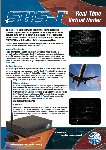Downlink Broadcast
The downlink broadcast frame is resent at regular intervals by the aircraft for a specific period time, at a nominal rate of 1 Hz. It includes the transmission of Extended Squitter - the unsolicited downlink broadcast of positional reports. The system „depends” on other aircraft systems, like a barometric encoder and GPS equipment for the position data.
The preamble of the Mode S downlink allows a synchronisation to a clock for decoding the Data Block which is coded with the Pulse-Posistion-Modulation (PPM). The Data format of an ADS-B message is the format number DF17. The content of the datafield DF is here the decimal number 17, in binary code 10001b.[1]

Figure 1: Data Block of an ADS-B message

Figure 1: Data Block of an ADS-B message
The three following bits (called “Capability”, or “CA”) ist the number of sub-type of the ADSB- message. The length 3 bit gives eight different kinds of reports. The next 24 bits are the individual Aircraft (ICAO) Address. The next Data field of 56 bits is the carrier of the ADS-B report, depending on the content of the “CA” field.
This report can include:
- aircraft type and aircraft ID
- altitude,
- encoded latitude,
- encoded longitude (both coarse), and
- airborne velocity.
The last 24 bits are the error detection code (Parity Information, PI).
Traffic Information Broadcast (TIS-B)
Traffic Information Broadcast (TIS-B) is used by airfield ground equipment, e.g. the Follow-me-Car or aircraft tow tractors.[2] The message uses the same structure as ADS-B but the format is named DF18 instead of DF17. This format designator is intended to support the broadcast of extended squitter ADS-B messages by non-transponder devices, i.e. they are not incorporated into a Mode S transponder of an aircraft. This separate format is used to clearly identify this non-transponder case to prevent Mode S interrogators from attempting to interrogate these devices.
SBS-1
The squitter information can be received and shown as a Real Time Radar display on your PC screen of Mode-S/ADS-B equipped aircraft the airspace immediately around your home. Such a receiver is described at www.javiation.co.uk. A lot of users of this ADS-B receiver are associated with www.virtual-radar.de.
The traffic around Zurich is represented in internet at radar.zhaw.ch, based on a diploma thesis from the suiss school of engineering in Zurich. The shown “radar informations” are originated on ADS-B “squitter” reports.
Source:
- ICAO Annex 10, Volume IV, 3.1.2.8.6 EXTENDED SQUITTER, DOWNLINK FORMAT 17, (p. 72)
- ICAO Annex 10, Volume IV, 3.1.2.8.7 EXTENDED SQUITTER/SUPPLEMENTARY, DOWNLINK FORMAT 18, (p. 77)

